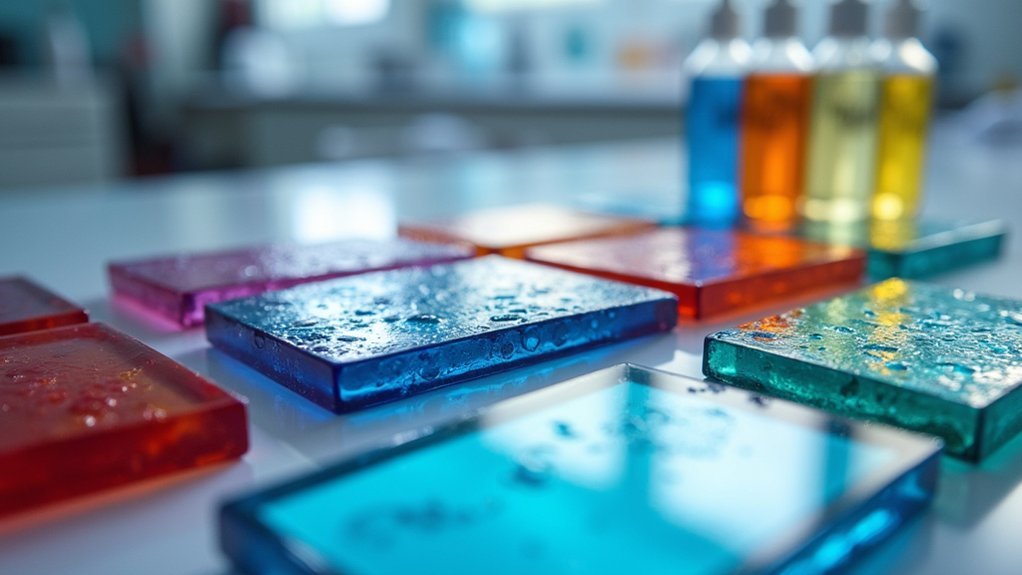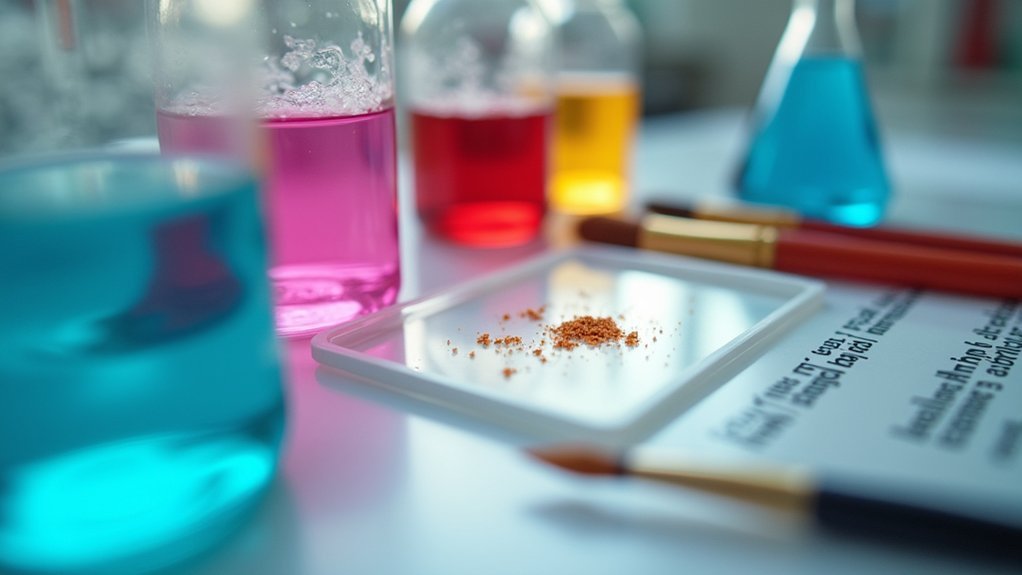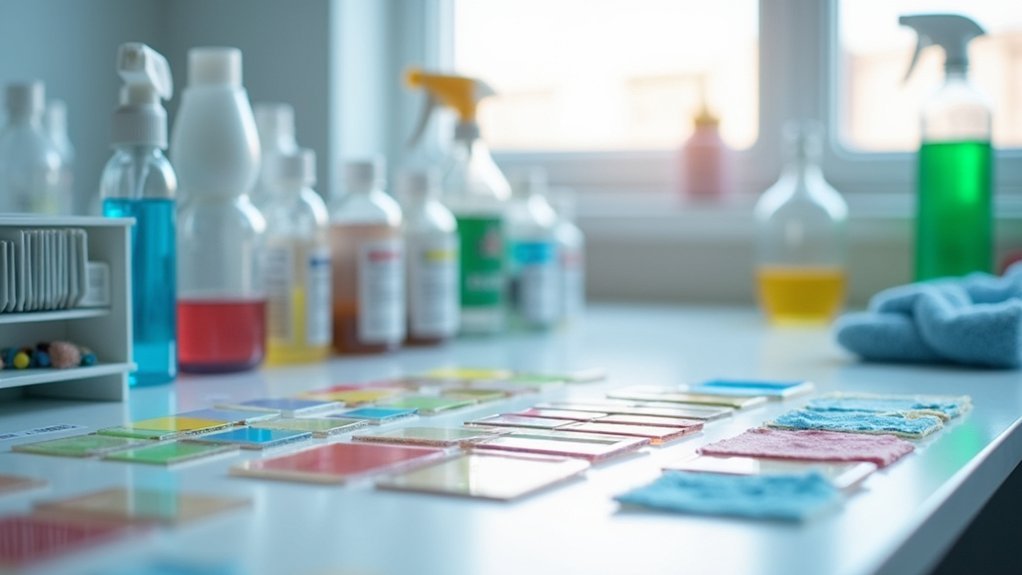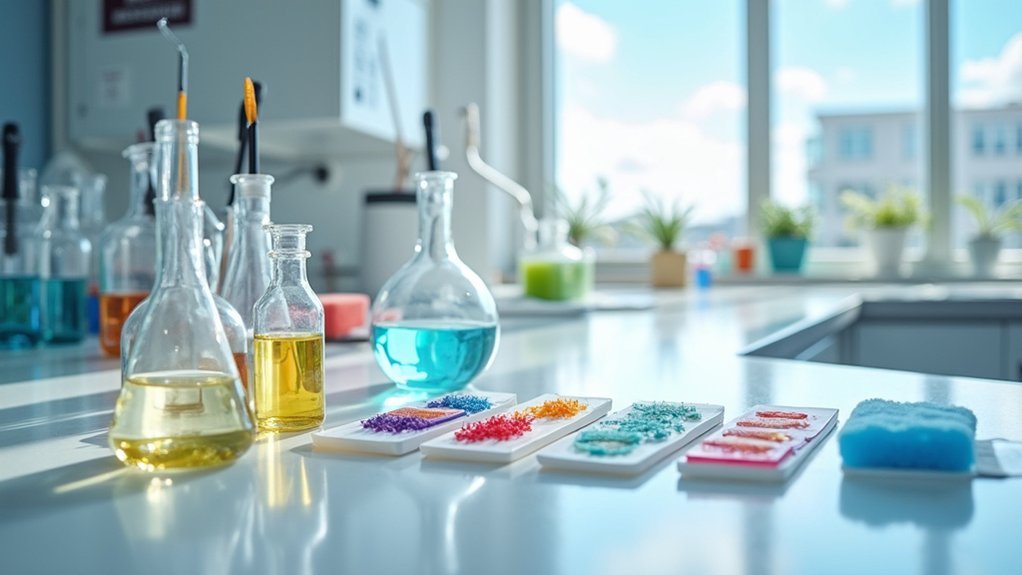To remove stubborn specimen stains, first soak the fabric in oxygen bleach and cool water for at least an hour. For tougher stains, apply hydrogen peroxide with a soft brush, working from the outside in. Rubbing alcohol works well on ink components, while a vinegar-water solution tackles greasy residues. Always test cleaners on an inconspicuous area first. Combine these chemical treatments with gentle circular scrubbing for maximum effectiveness. These techniques will transform your stain removal results.
Understanding Specimen Stain Types and Their Properties

Specimens of all types can leave behind stubborn marks that seem impossible to remove. When dealing with these challenging stains, you’ll need to identify what you’re working with first.
Blood stains are protein-based and become more difficult to remove when dry, requiring immediate treatment with cold water and enzyme-based detergents.
Tissue stains often contain pigments that bond strongly to surfaces, necessitating specialized cleaning products that can break down these compounds without damaging the material.
Meanwhile, bodily fluids like urine and saliva not only stain but harbor bacteria, making disinfectants essential companions to your stain removers.
Pre-Treatment Methods for Releasing Embedded Stains
Once you’ve identified the type of stain you’re dealing with, swift action with the right pre-treatment method can make all the difference.
For specimen stains, soak the fabric in oxygen bleach and cool water for at least an hour before washing to loosen embedded materials.
When tackling ink stains, use a cotton swab with rubbing alcohol, working from the outside toward the center to prevent spreading.
For greasy spots, apply a 50/50 distilled white vinegar and water solution before using heavy-duty detergent.
Fresh food stains respond well to immediate treatment with dish soap and water. This prevents setting and makes the stain easier to remove later.
Always test your stain remover on an inconspicuous area first to verify it won’t damage your fabric.
Effective Solvents and Chemical Removal Techniques

Three powerful chemicals can make the difference between a permanent mark and a clean surface.
Rubbing alcohol is your go-to solvent to remove ink stains—apply with a cotton swab from the outside inward to prevent spreading.
Say goodbye to stubborn ink marks—rubbing alcohol applied from edges inward keeps stains from spreading while dissolving them completely.
For blood and protein-based stains, hydrogen peroxide breaks down these stubborn marks; consider using it with a soft-bristled brush for better penetration.
When tackling grease stains, use a 50/50 vinegar and water solution before applying laundry detergent. The acidic properties help break down the oil components.
For set-in stains, try ammonia solutions mixed in a 1:2 ratio with water. Let it sit for at least 10 minutes, then blot.
Always test one small area first to verify your material won’t be damaged.
Mechanical Cleaning Approaches for Stubborn Residues
When chemical solutions alone won’t budge those persistent marks, mechanical cleaning techniques offer powerful alternatives. You’ll find that combining a soft-bristled brush with an appropriate cleaning solution creates a powerful duo for stubborn stains. The liquid penetrates while the brushing action provides adequate friction to lift tough residues.
For more effective stain removal, try scrubbing in circular motions rather than back-and-forth—this technique breaks down stubborn deposits more efficiently.
If you’re working with sensitive surfaces, opt for non-abrasive pads that won’t cause scratching while still providing enough friction to remove the stain.
For outdoor surfaces with particularly stubborn stains, consider using a high-pressure water blaster to forcefully dislodge dirt without damaging the underlying material.
Preventative Measures and Long-Term Stain Management

The best approach to stubborn stains isn’t just removing them—it’s preventing them from occurring in the first place. Effective stain management begins with proactive measures that protect your surfaces and minimize permanent stains.
Prevention is the ultimate stain solution—protect your surfaces before damage occurs.
Apply a protective sealant to natural stone regularly and clean spills immediately with neutral detergents to prevent spreading of tough stains.
To maintain stain-free surfaces:
- Establish a regular cleaning schedule to avoid buildup of dirt that can lead to stubborn staining.
- Research specific cleaning products appropriate for each surface type to avoid damage.
- Store potentially staining substances in secure containers to reduce accidental spills.
Frequently Asked Questions
How Do You Get Rid of Stains That Won’t Come Out?
For stubborn stains, you’ll need to identify the type first. Try oxygen bleach for wine, rubbing alcohol for ink, vinegar mixtures for grease, and cold water treatments for blood. Don’t dry until the stain’s gone.
What Is the Best Stain Remover for Old Stubborn Stains?
For old stubborn stains, you’ll find oxygen bleach most effective on fabrics, while ammonia-water solutions work well generally. Don’t forget specialized removers like Fila PS87 for stone surfaces and rubbing alcohol for ink stains.
What Is a Natural Stubborn Stain Remover?
For natural stubborn stain removal, you’ll love combining white vinegar and baking soda’s foaming action with hydrogen peroxide’s bleaching properties. Add a few drops of tea tree oil for antibacterial benefits and a pleasant scent.
How Do You Get Rid of Tough Stains Easily?
You’ll get rid of tough stains easily by acting fast. Flush with cold water immediately, then apply the right solution—vinegar for coffee or wine, alcohol for ink, and cold water for blood stains.
In Summary
Don’t let specimen stains derail your work. You’ve now got five powerful techniques in your arsenal to tackle even the most resistant marks. Remember to identify your stain first, then choose the appropriate pre-treatment, solvent, or mechanical method. By implementing preventative measures as part of your routine, you’ll spend less time cleaning and more time on valuable research.





Leave a Reply